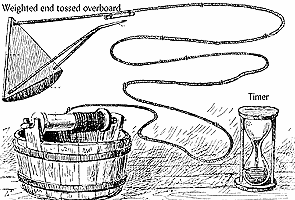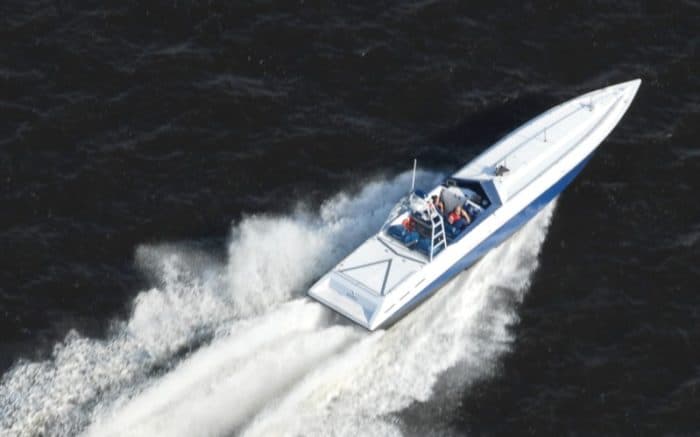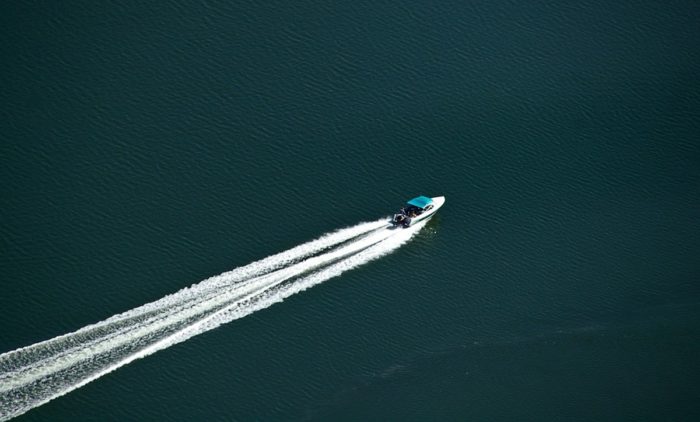Knots to Miles Per Hour: Understanding Boat Speed
One of the hardest things for new boaters to understand is speed on the water. We’re very used to miles per hour on land. But on the water there are nautical miles and knots. How and why are they different? Let’s take a look.
Calculating Knots to Miles Per Hour
One knot equals roughly 1.15 miles per hour. The exact measurement is metric and works out to 1852.000 meters per hour. The actual number is 1.15077945 miles per hour but obviously that’s very specific. Calculating boat speed is fairly simple when you know this.
If you wish to find miles per hour based on knots then you multiply. In this case, miles per hour = knots × 1.15077945.
So if you’re travelling at 16 knots then the equation is 16 x 1.15077945
16 x 1.15077945 = 18.41247 miles per hour
If you wish to calculate knots based on miles per hour then we need to reverse the formula. In this case, knots = mph/1.15077945.
If you’re travelling at 44 miles per hour then the equation would be 44/1.15077945
44/1.15077945 = 38.23495 knots
For simplicity sake, most calculations round down to 1.15
The Difference Between One Mile and One Nautical Mile
Nautical miles are longer than miles on land. 1 nautical mile is roughly 1.15 land miles. Because coordinates at sea are measured in longitude and latitude, nautical miles follow these measurements. Each nautical mile equals one minute of latitude as measured at the Earth’s equator. This number was derived using equations which gave not entirely precise answers. That’s why in the US a nautical mile was 6080.2 feet. In Britain it was rounded to 6080. And, as we’ll see, this is slightly different than the currently accepted international nautical mile.
The earth is divided up into 360 degrees. Each degree has 60 minutes. That makes the distance around the earth at the equator roughly. 21,600 nautical miles.
The mathematician Pythagoras who you no doubt remember from school came up with the idea of a spherical earth. This set the groundwork for laying out longitude and latitude and, in turn, evenly dividing the earth into minutes and degrees.
It’s ironic that a nautical mile, which is based on mathematics, is so close in length to a standard mile, which is not. Miles originated with the Romans. A Roman mile was the distance soldiers covered with 1000 double paces. A double pace was, on average, around 5 feet. So a Roman mile was 5000 feet.
A current mile, you may recall, is 5,280 feet. So where’s the difference? Well, we can thank England for that. These non-metric measurements all came from England with some Roman influence. The statute mile, or imperial mile is based not on how far Romans can march but on furlongs. One mile equals 8 furlongs. One furlong is 660 feet.
Where’d a furlong come from? Farmers. One furlong was supposed to be the length of field an ox could plow before it needed a rest. That’s obviously very vague so over time it was standardized to 660 feet.
When the British were standardizing their systems of measurement, they needed to meld their system with the Roman system. A Roman mile was just shy of 8 furlongs. So to make the math easier, they just added to the Roman mile. Thus you get an extra 280 feet and an even 8 furlongs.
The fact that a nautical mile is actually so close to a statute mile is probably why the word “mile” is used. But it’s worth noting there are actually several different miles in the world. The statue mile and the nautical mile are different, and we already mentioned the Roman mile.
An Italian mile is 1000 paces while a Chinese mile is 500 meters. A Saxon mile is just over 9 kilometers. And there are still many more.
What is an International Nautical Mile?
Historically, as we’ve said, one minute of latitude has been used to define a nautical mile. But this has been standardized to the international nautical mile which makes it a little more precise. An international nautical mile works out to 1852 meters or 6076 ft.
As we said earlier, a US nautical mile was 2080.2 feet and a British one was 2080. Both countries have since adopted the international standard. The US took up the international nautical mile in 1954. Britain did so in 1970.
What Are Knots?
Nautical miles are not measured in nautical miles per hour, which seems like it would make sense. Instead, we measure them in knots. This is another likely point of confusion for anyone new to boating. The origins of the knot go back into history and are closely related to something called the chip log.
Long before electronic forms of measure speed were available, sailors and navigators had to be more clever. Figuring out your speed at sea in a time before modern technology was not easy. So they came up with an ingenious solution.

The line holding the chip log features uniformly spaced knots. The spacing was 47 feet and 3 inches apart. Another sailor would use an hourglass which measured intervals of 28 seconds to measure the time it took to drag the chip line from one knot to the next. The number of knots that passed by over a specific period of time indicated the speed at which the vessel was travelling. Thus, a knot measures speed. The reading was then recorded in the ship’s common log.
The difference between this ancient measurement and the modern mathematical standard is surprisingly little. Using these measurements a knot worked out to around 20.25 in/s. In miles per hour, that works out to 1.1505682. Compare that to the modern standard of 1.15077945. As you can see, it’s amazingly accurate and would have been a solid method of measuring speed. The only errors would have been human or technological, such as someone mistiming or the chip log getting tangled, for instance.
In modern times, measuring speed has been upgraded and standardized. We now measure nautical miles and not the distance between knots in a rope, However, the name stuck so we still use it.
One knot equals one nautical mile per hour
Why Use Nautical Miles at All?
The most common complaint a new boater will have when figuring out distances is why? If we can use miles on land, why not the same units on water? And the answer is one of practicality. At the end of the day, a mile as we understand it on land doesn’t mean anything. It started as a measurement of troops marching. It adapted to cover how much plowing an ox can do. It’s pretty silly when you think about it. The measurement is very arbitrary and offers little practical information about distance.
A nautical mile represents a very specific distance relevant to sailors. It’s that one minute of latitude. Because longitude and latitude coordinates are so important for travel at sea, this makes sense. This is how nautical charts are laid out. Not only does the unit of measurement make more sense, it makes travel easier and safer. After all, travel a few miles down any road and you’re still on a road. Travel a few nautical miles at sea and you can be anywhere. It’s a vast and open place that can be dangerous. Ensuring that you measure everything as accurately as you can is important for your safety and understanding of where you are.
Categories: Tools and Calculators














